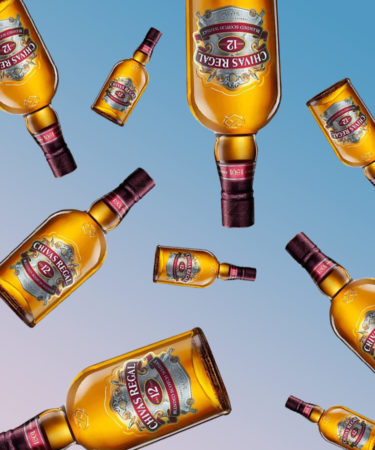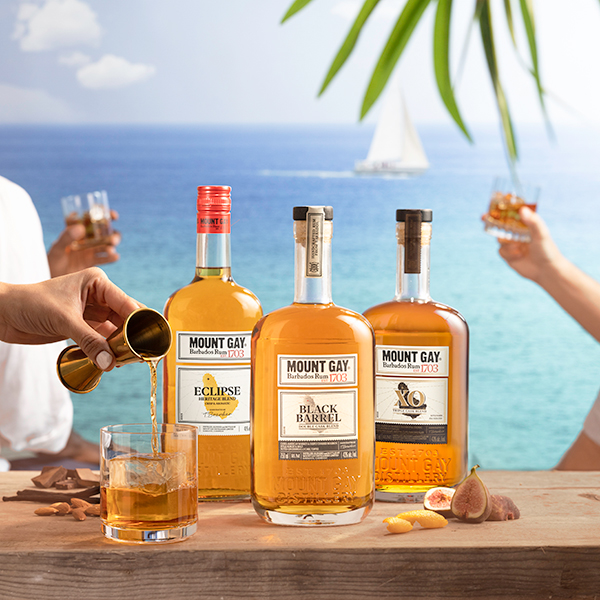Sure, in high school terms, “single malt” is the transfer theater kid who also makes the varsity football team — moody, brooding, and unapproachable at first, he’ll win you over and take your lunch money. But that doesn’t make blended Scotch whisky a hyper-approachable, insipidly friendly, “sign-my-yearbook-or-I’ll-scream” airhead.
Witness: Chivas Regal, which debuted Stateside in 1909 as a 25 year-old self-described “luxury” blended Scotch whisky (in a pretty sleek bottle, no less). For over a century in the U.S. market, Chivas has banked on the quality and artistry and finesse of blended whiskies (its roots trace back to 1801, but more on that later). Chivas was so successful in preaching the gospel of blended whisky, it’s now acknowledged to be the apex blended whisky by the brand experts (one even wrote a book about it).
Granted, sales of single malt surged (9.4 percent since 2002), and sales of blended Scotch whisky ever-so-slowly declined (0.6 percent in the same time period). But the market follows trends, not quality. And given possibly lower price points, now might be the time to invest attention — and maybe 30 bucks — in the first blended Scotch that asserted itself as a worthy shelfmate to single-malt Scotch.
Here are 10 things you should know about Chivas Regal.
Yes, it’s blended. That’s not bad.
Let’s get this out of the way: Chivas is a blended Scotch whisky. That’s not bad, or verboten, or icky. Some clarification on Scotch terminology: “Single malt” means malted barley whisky from one distillery, so any Scotch that isn’t labeled “single malt” is blended, meaning made with a mixture of single malt(s) with cheaper grain-based whiskies.
Heresy? Not really. Even as blended sales have dipped since 2002, blended Scotch still makes up 75 percent of the market in the U.S. We love it, largely because it’s lush and reliably consistent.
The Chivas brothers started as grocers. That matters.
John and James Chivas were grocers first, then distillers later, with James as the driving force in the whisky side of the business. This isn’t just a piece of bio history to flash at a cocktail party. The fact that the Chivases (Chivasae?) began as grocers hints at exactly why they became the name behind the world’s first luxury blended (not single-malt) whisky. Think of it from a grocer’s viewpoint: Serving customers daily, chasing after the simultaneous demand for consistency and quality, a blended Scotch makes more sense.
As opposed to finicky, pricier single malts, blended Scotch can be a reliable high-end product, if conceptually down a peg from single-malt snobbery. Think of it like getting a Nitro Cold Brew at Starbucks versus waiting 45 minutes for a coffee yogi to bless your pour-over at Blue Bottle. Both have their selling points.
It’s 100 years younger (or older) than it says.
The Chivas Regal bottle neck says “Established 1801 Aberdeen.” This is true. But Chivas Regal (so called) didn’t launch until 1909. That’s also true. The elements that go into what Chivas Regal is today came at different times: The grocery that became the foundation for the distillery business began in Aberdeen in 1801. The first-ever-christened “Chivas Regal” 25-year-old blended Scotch whisky that launched the brand debuted in 1909. Meaning, yes, the brand can lie about its age (and haven’t we all added or shaved off a century at some point?).
Chivas Regal comes from the most prolific place Scotch is made.
Chivas Regal is produced at Strathisla Distillery in Speyside, the most prolific Scotch-producing region in the country. And while Scotland has been producing Scotch for half a millennium, give or take, Strathisla is still the oldest working distillery in the Highlands, cutting its first batch all the way back in 1786. FYI, Chivas didn’t purchase Strathisla until 1950 — it had been blending with Strathisla’s single malt — but Scotch tourists should be happy they eventually did.
Its distillery is one of the most beautiful in the world.
Any working distillery is beautiful (it produces Scotch whisky, ‘nuf said). And Ron Swanson does his whisky tourism single-mindedly. But Strathisla Distillery repeatedly shows up on “Most Beautiful Distillery” lists, and with good reason. There’s something about the squat, cottage-like stone structure with its sloping cupola roofs that makes it look like a Hogwarts-meets-Hobbiton dreamland (plus Scotch).
Chivas Regal is like Benjamin Button.
The Chivas brothers got their start in the mid-19th century, but “Chivas Regal,” the first-ever luxury whisky brand, was born in 1909 as the brainchild of Chivas master blenders Charles Howard and Alexander Smith. Its American debut was a smash, but Prohibition put an end to all our whisky-fueled Charleston-ing until 1938, when Chivas Regal came back, half as old, the 12-year baseline expression available today.
Chivas 18-Year is likely the better investment.
Chivas 12-year is reliably smooth and delicately sweet, laced with Speyside elements like chewy fruit and even hints of papery nutshell, but two-note grain whisky can singe a bit too hot. Things tend to get more interesting, and closer to Chivas’s O.G. luxury vibe, with the 18-year expression, the personal creation of Chivas modern-era master blender Colin Scott.
Granted, prices just about double for this bottle, from the $30 range to the $70 range, but if you’re looking to convince anyone of the seductive prowess of a well-curated blend, it’s worth the splurge (think fruit, feathery spice, toffee, dried citrus peel, etc.).
Chivas Regal turned its blends into art. 3D DNA portraits, to be exact.
Another reason to sip and serve the 18-Year is that you can chuck out this intel: Looking to create harmony or just confuse everyone, in 2016 Chivas debuted Chivas ULTIS, a “Blended Malt”— a blend, yes, but a blend of single malts from five different distilleries (though technically it’s really a vatting and not a blending when it’s combining single malts only).
To honor the accomplishment, Chivas partnered with a company that specializes, among other things, in turning DNA molecules into — what else? — 3D art, creating five distinct digital DNA “portraits” for the five master blenders from the five distilleries that contributed to ULTIS. The result is this, which is uniquely fascinating and definitely makes us want to drink more. (If you want to try to make sense of it, then pass out, here you go.)
It released the first mizunara oak-aged Scotch in the States.
Chivas doesn’t shy away from the precious or persnickety (see aforementioned DNA 3D art). Case in point: In 2019, Chivas released the first mizunara-aged blended Scotch in the States, meaning a portion of what’s in the bottle has aged in mizunara oak, a combination of two Asian oak trees that’s highly porous and prone to more barrel interaction. Reviews are generally positive, noting flavors like sweetness and soft flora, wood, vanilla, spiciness, toffee, tropical fruit notes, and “delicious complexity.” Yum. Also stealing that for Tinder profile.
Hunter S. Thompson drank it for breakfast.
According to this Associated Press article reprint of a Thompson biography, our very own (and much-mourned) manic scribe started his day with Chivas at 3 p.m., did some, er, other stuff, then hit up Chivas again at 3:50. Bear in mind, this is Hunter S. Thompson, so “breakfast” is a relative term. In any case, Thompson proved even a “luxury” whisky could be responsibly incorporated into a working journalist’s daily routine.
Those who don’t read the abominable — possibly apocryphal — daily consumption diary carefully might miss the “three or four jiggers of Chivas” lashed over shredded ice as the finale to Thompson’s bacchanalian lunch, for digestion and/or final damnation. P.S.: Do not try this at home. He wasn’t an entirely happy guy.

